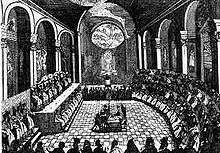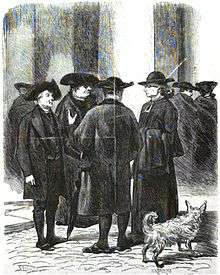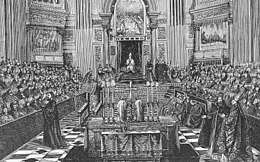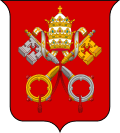First Vatican Council
The First Vatican Council (Latin: Concilium Vaticanum Primum) was convoked by Pope Pius IX on 29 June 1868, after a period of planning and preparation that began on 6 December 1864.[1] This, the twentieth ecumenical council of the Catholic Church, held three centuries after the Council of Trent, opened on 8 December 1869 and adjourned on 20 October 1870.[2] Unlike the five earlier general councils held in Rome, which met in the Lateran Basilica and are known as Lateran councils, it met in the Vatican Basilica, hence its name. Its best-known decision is its definition of papal infallibility.[3]
| First Vatican Council | |
|---|---|
 | |
| Date | 1869–1870 |
| Accepted by | Catholic Church |
Previous council | Council of Trent (1545–1563) |
Next council | Second Vatican Council (1962–1965) |
| Convoked by | Pope Pius IX |
| President | Pope Pius IX |
| Attendance | 744 |
| Topics | Rationalism, liberalism, materialism; inspiration of Scripture; papal infallibility |
Documents and statements | Dei Filius, Pastor aeternus |
| Chronological list of ecumenical councils | |
| Part of a series on |
| Ecumenical councils of the Catholic Church |
|---|
 Renaissance depiction of the Council of Trent |
| Antiquity (c. 50 – 451) |
| Early Middle Ages (553–870) |
|
| High and Late Middle Ages (1122–1517) |
|
| Modernity (1545–1965) |
|
|
The council was convoked to deal with the contemporary problems of the rising influence of rationalism, liberalism, and materialism.[4] Its purpose was, besides this, to define the Catholic doctrine concerning the Church of Christ.[5] There was discussion and approval of only two constitutions: the Dogmatic Constitution on the Catholic Faith (Dei Filius) and the First Dogmatic Constitution on the Church of Christ (Pastor aeternus), the latter dealing with the primacy and infallibility of the Bishop of Rome.[5] The first matter brought up for debate was the dogmatic draft of Catholic doctrine against the manifold errors due to rationalism. The Council condemned rationalism, liberalism, naturalism, materialism and pantheism. The Catholic Church was on the defensive against the main ideology of the 19th century.[6]
Background
This council was summoned by Pope Pius IX by a bull on 29 June 1868.[1] The first session was held in St. Peter's Basilica on 8 December 1869.[7] Preliminary sessions dealt with general administrative matters and committee assignments. Bishop Bernard John McQuaid complained of rainy weather, inadequate heating facilities, and boredom.[8] Bishop James Roosevelt Bayley of Newark, New Jersey, noted the high prices in Rome.[8] When Lord Houghton asked Cardinal Manning what had been going on, he answered: “Well, we meet, and we look at one another, and then we talk a little, but when we want to know what we have been doing, we read the Times”.[9]
Papal infallibility
| Papal primacy, supremacy and infallibility |
|---|
|
Overview
|
|
Patriarchs compared to popes
|
|
Ecumenical councils compared to popes
|
|
Catholic episcopal councils compared to popes
|
|
Political rulers compared to popes
|
|
Existing dogma compared to popes
|
|
Objections and controversy
|
The doctrine of papal infallibility was not new and had been used by Pope Pius in defining as dogma, in 1854, the Immaculate Conception of Mary, the mother of Jesus.[10] However, the proposal to define papal infallibility itself as dogma met with resistance, not because of doubts about the substance of the proposed definition, but because some considered it inopportune to take that step at that time.[10] Richard McBrien divides the bishops attending Vatican I into three groups. The first group, which McBrien calls the "active infallibilists", was led by Henry Edward Manning and Ignatius von Senestréy. According to McBrien, the majority of the bishops were not so much interested in a formal definition of papal infallibility as they were in strengthening papal authority and, because of this, were willing to accept the agenda of the infallibilists. A minority, some 10 per cent of the bishops, McBrien says, opposed the proposed definition of papal infallibility on both ecclesiastical and pragmatic grounds, because, in their opinion, it departed from the ecclesiastical structure of the early Christian church.[11] From a pragmatic perspective, they feared that defining papal infallibility would alienate some Catholics, create new difficulties for union with non-Catholics, and provoke interference by governments in ecclesiastical affairs.[12] Those who held this view included most of the German and Austro-Hungarian bishops, nearly half of the Americans, one third of the French, most of the Chaldaeans and Melkites, and a few Armenians.[12] Only a few bishops appear to have had doubts about the dogma itself.[12]
Dei Filius
On 24 April 1870, the dogmatic constitution on the Catholic faith Dei Filius was adopted unanimously. The draft presented to the council on 8 March drew no serious criticism, but a group of 35 English-speaking bishops, who feared that the opening phrase of the first chapter, "Sancta romana catholica Ecclesia" ('Holy Roman Catholic Church'), might be construed as favouring the Anglican branch theory, later succeeded in having an additional adjective inserted, so that the final text read: "Sancta catholica apostolica romana Ecclesia" ('Holy Catholic Apostolic Roman Church').[13] The constitution thus set forth the teaching of the "Holy Catholic Apostolic Roman Church" on God, revelation and faith.[14]
Pastor aeternus

There was stronger opposition to the draft constitution on the nature of the church, which at first did not include the question of papal infallibility,[4] but the majority party in the council, whose position on this matter was much stronger,[10] brought it forward. It was decided to postpone discussion of everything in the draft except infallibility.[10] The decree did not go forward without controversy; Cardinal Filippo Guidi, Archbishop of Bologna, proposed adding that the pope is assisted by "the counsel of the bishops manifesting the tradition of the churches". Pius IX rejected Guidi's view of the bishops as witnesses to the tradition, maintaining: "I am the tradition."[15]
On 13 July 1870, a preliminary vote on the section on infallibility was held in a general congregation: 451 voted simply in favour (placet), 88 against (non placet), and 62 in favour but on condition of some amendment (placet iuxta modum).[16] This made evident what the final outcome would be, and some 60 members of the opposition left Rome so as not to be associated with approval of the document. The final vote, with a choice only between placet and non placet, was taken on 18 July 1870, with 433 votes in favour and only 2 against defining as a dogma the infallibility of the pope when speaking ex cathedra.[4] The two votes in opposition were cast by Bishops Aloisio Riccio and Edward Fitzgerald.[17]
The dogmatic constitution states, in chapter 4:9, that the Pope has "full and supreme power of jurisdiction over the whole Church" (chapter 3:9); and that, when he:
speaks ex cathedra, that is, when, in the exercise of his office as shepherd and teacher of all Christians, in virtue of his supreme apostolic authority, he defines a doctrine concerning faith or morals to be held by the whole Church, he possesses, by the divine assistance promised to him in blessed Peter, that infallibility which the divine Redeemer willed his Church to enjoy in defining doctrine concerning faith or morals
None of the bishops who had argued that proclaiming the definition was inopportune refused to accept it. Some Catholics, mainly of German language and largely inspired by the historian Ignaz von Döllinger, formed the separate Old Catholic Church in protest; von Döllinger did not formally join the new group himself.[18]
Suspension

Discussion of the rest of the document on the nature of the church was to continue when the bishops returned after a summer break. However, in the meanwhile the Franco-Prussian War broke out. With the swift German advance and the capture of Emperor Napoleon III, French troops protecting papal rule in Rome withdrew from the city.
Consequently, on 20 September 1870, one month after the Kingdom of Italy had occupied Rome, Pope Pius IX, who then considered himself a prisoner in the Vatican, issued the bull Postquam Dei munere, adjourning the council indefinitely. While some proposed to continue the council in the Belgian city of Mechlin, it was never reconvened.[19] The council was formally closed in 1960, prior to the formation of the Second Vatican Council.[20]
See also
| Wikimedia Commons has media related to Participants in the First Vatican Council. |
References
Notes
- Kirch 1912, p. 303.
- Kirch 1912, p. 303; Nobili-Vitelleschi 1876, p. 1.
- "Vatican Council, First" 2001.
- "First Vatican Council" 2014.
- Tanner 1990.
- Kirch 1912, p. 304.
- Nobili-Vitelleschi 1876, p. 1; Tanner 1990.
- "The First Vatican Council". America. 8 September 1962. Archived from the original on 15 September 2015. Retrieved 2 March 2018 – via Conciliaria.
- Hare, Augustus (1896). The Story of My Life. II. New York: Dodd, Mead and Company. p. 504.
- Burton & Woodruff 2014.
- McBrien 1995, p. 1297.
- Kirch 1912, p. 305.
- Lacoste 2004, p. 1666.
- De Mattei 2004, p. 137.
- Duffy 2014, loc. 5428–5439.
- Hughes 1961, pp. 342, 362.
- Hughes 1961, pp. 364, 381; Kirch 1912, p. 307.
- Hennesey 2009.
- Kirch 1912, p. 307.
- "Vatican I". Vatican.com. 22 May 2018. Retrieved 25 February 2019.
Bibliography
- Burton, Ivor F.; Woodruff, Douglas (2014). "Pius IX". Encyclopædia Britannica. Encyclopædia Britannica. Retrieved 2 March 2018.CS1 maint: ref=harv (link)
- De Mattei, Roberto (2004). Pius IX. Translated by Laughland, John. Leominster, England: Gracewing.CS1 maint: ref=harv (link)
- Duffy, Eamon (2014). Saints and Sinners: A History of the Popes (4th ed.). New Haven, Connecticut: Yale University Press. ISBN 978-0-300-11597-0.CS1 maint: ref=harv (link)
- "First Vatican Council". Encyclopædia Britannica. Encyclopædia Britannica. 2014. Retrieved 2 March 2018.
- Hennesey, James (2009). "First Vatican Council". Encarta. Microsoft. Archived from the original on 31 October 2009. Retrieved 2 March 2018.CS1 maint: ref=harv (link)
- Hughes, Philip (1961). The Church in Crisis: A History of the General Councils, 325–1870. Garden City, New York: Hanover House. Retrieved 3 March 2018.CS1 maint: ref=harv (link)
- Kirch, J. M. Konrad (1912). . In Herbermann, Charles G.; Pace, Edward A.; Pallen, Condé B.; Shahan, Thomas J.; Wynne, John J. (eds.). Catholic Encyclopedia. 15. New York: The Encyclopedia Press (published 1913). pp. 303–309.CS1 maint: ref=harv (link)
- Lacoste, Jean-Yves (2004). "Vatican I, Council of". Encyclopedia of Christian Theology. New York: Routledge. ISBN 978-1-57958-250-0.CS1 maint: ref=harv (link)
- McBrien, Richard P., ed. (1995). The HarperCollins Encyclopedia of Catholicism. New York: HarperCollins. ISBN 978-0-06-065338-5.CS1 maint: ref=harv (link)
- Nobili-Vitelleschi, Francesco (1876). The Vatican Council: Eight Months at Rome during the Vatican Council. London: John Murray. Retrieved 3 March 2018.CS1 maint: ref=harv (link)
- Tanner, Norman P., ed. (1990). "First Vatican Council (1869–1870)". Decrees of the Ecumenical Councils. Retrieved 2 March 2018 – via EWTN.CS1 maint: ref=harv (link)
- "Vatican Council, First". The Columbia Encyclopedia (6th ed.). New York: Columbia University Press. 2001. Archived from the original on 18 June 2001. Retrieved 3 March 2018.
Further reading
- Catalogo alfabetico degli eminentissimi cardinali, patriarchi, primati, arcivescovi, vescovi, abati generalí e generalí degli ordini religiosi presenti in Roma che hanno sede nel Concilio I° Ecumenico Vaticano aperto l'8 decembre 1869 con l'indicazone de' respettivi domicili aggiuntivi in fine i nomi degli officiali del concilio (in Italian). Rome: L'Osservatore Romano. 1869. Retrieved 2 March 2018.
- De Cesare, Raffaele (1909). The Last Days of Papal Rome. Translated by Zimmern, Helen. London: Archibald Constable & Co.
- Hales, E. E. Y. (1958). The Catholic Church in the Modern World: A Survey from the French Revolution to the Present. Garden City, New York: Doubleday.
- Hasler, August Bernhard (1981). How the Pope Became Infallible: Pius IX and the Politics of Persuasion. Garden City, New York: Doubleday.
- Mirbt, Carl Theodor (1911). . In Chisholm, Hugh (ed.). Encyclopædia Britannica. 27. New York: Encyclopædia Britannica. pp. 947–951.
- Prusak, Bernard P. (2004). The Church Unfinished: Ecclesiology through the Centuries. New York: Paulist Press. ISBN 978-0-8091-4286-6.
